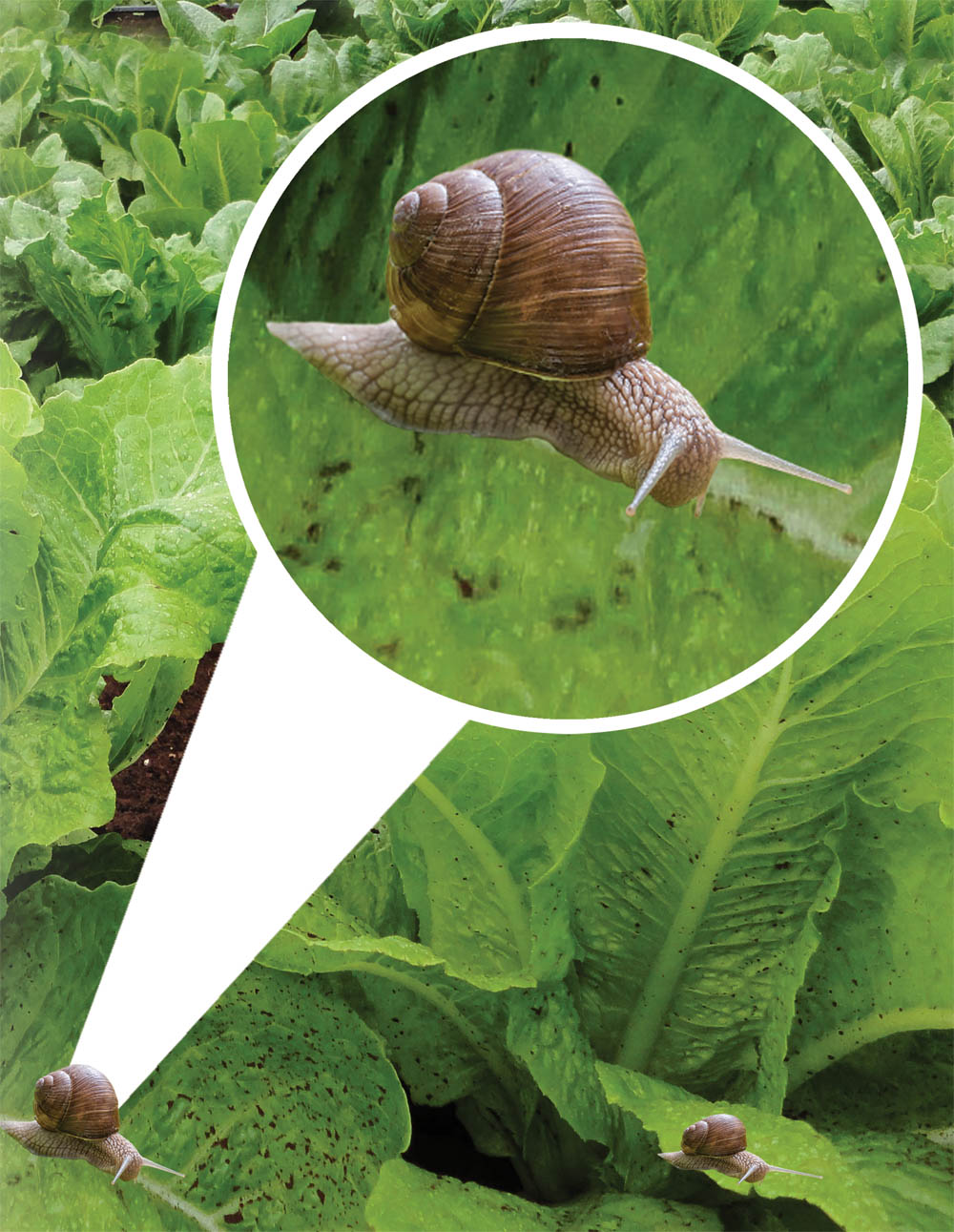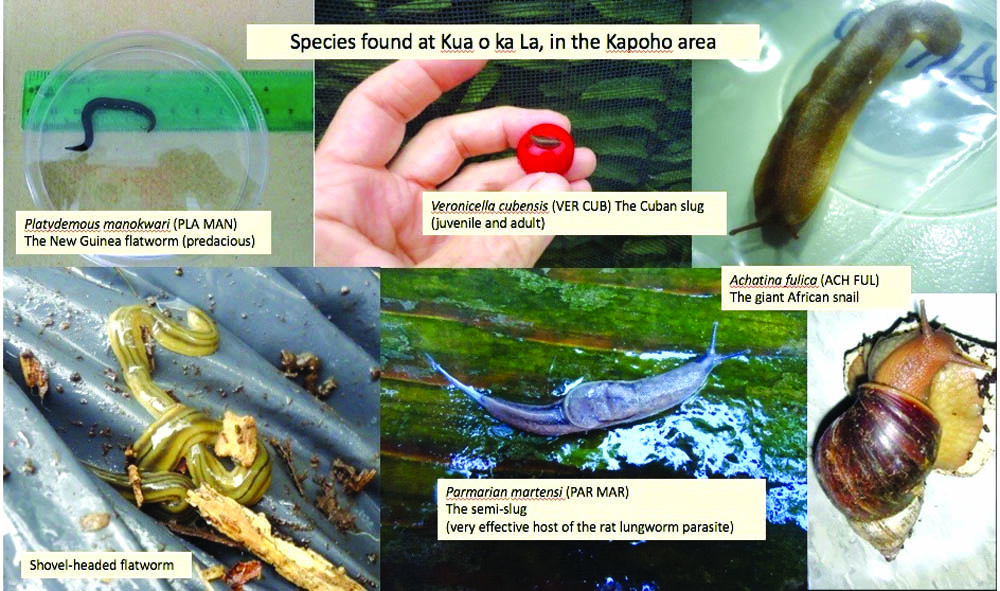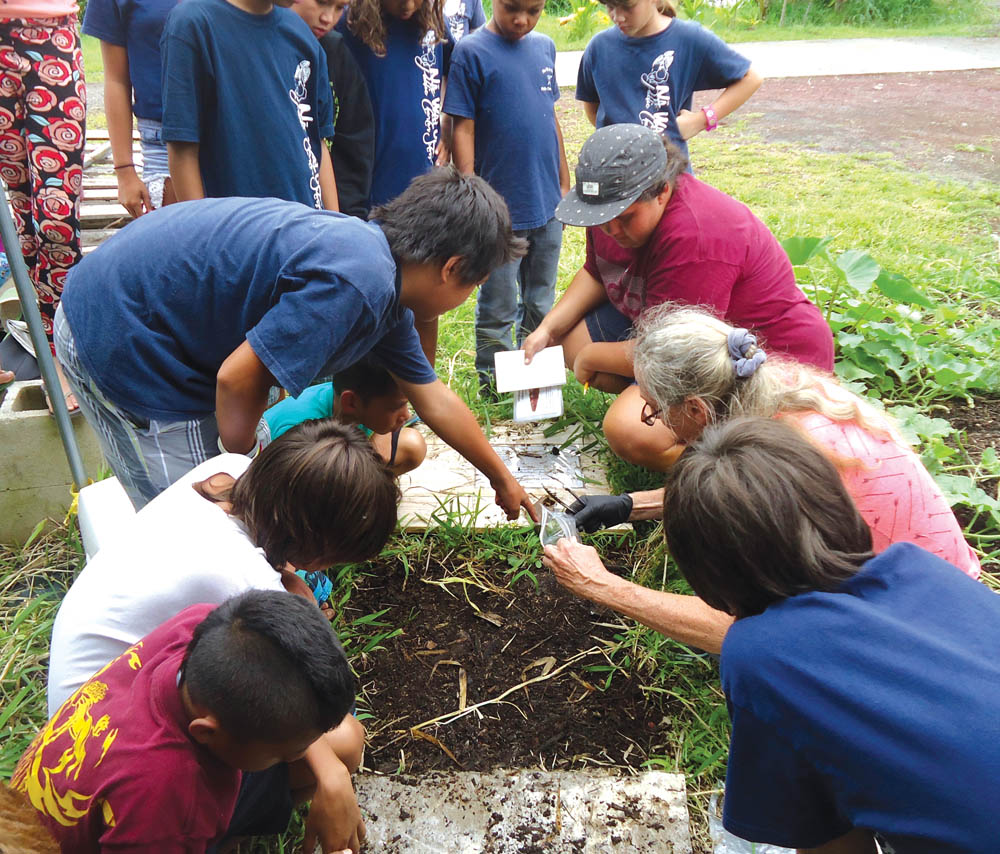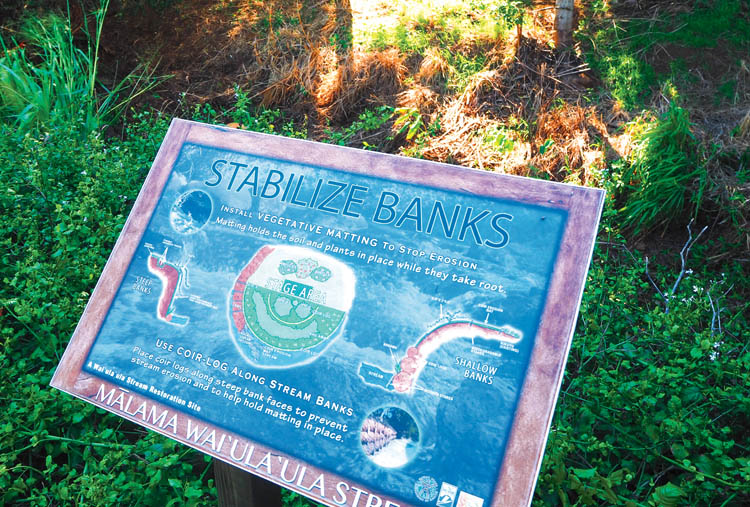
Rat Lungworm Disease: Optimism Comes with Education
 By Stefan Verbano
By Stefan Verbano
Inside garden hoses, along the walls of rain catchment tanks, between the folds of lettuce leaves, the slugs and snails slither. Although they look just like their harmless mainland cousins, these Hawaiian gastropods harbor a strange and potentially life-threatening parasite known as the rat lungworm.

On Hawai‘i Island, where residents and visitors alike battle fire ants, mosquitoes, coqui frogs, and giant cockroaches, the common slug and snail species found chomping on leafy greens or crawling across water tanks may seem like mild tropical nuisances; however, accidentally eat an infected baby slug hidden in a salad, gulp down a kale smoothie with a tiny piece of infected snail inside, or drink untreated catchment water that’s been contaminated with rat lungworm, and it’s possible to contract a disease which causes extreme pain, disability, paralysis, coma—even death.
The lifecycle of the parasite reaches its adult stage in the lungs of rats, hence the disease’s name. Rats excrete the worms’ offspring (larvae) in their feces, which is consumed by “intermediate hosts” such as slugs, snails, and flatworms, causing their infection. After rats eat the infected slugs and snails, the parasite’s lifecycle completes when the worms again mature in the rat’s lungs.
The parasite infestation of local rats plays a crucial role in the severity of rat lungworm infection in successive hosts. A study conducted on Hawai‘i Island in 2017 tested more than 500 rats collected in and around Hilo. It found rat lungworm in 94 percent of specimens. As the natural reservoir for the parasite, these rats, with their extremely high infection rates, are driving up the population of highly infectious intermediate hosts on the island.
The parasites came to Hawai‘i in the early 1960s when the first reports of rat lungworm-infected animal hosts appeared on O‘ahu, spreading from there to Maui, Kaua‘i, and Hawai‘i Island. Two decades ago the disease was distributed much more evenly across the islands. The introduction of a new species of semi-slug called P. martensi to East Hawai‘i right after the turn of the millennium seems to have caused a spike in cases of rat lungworm disease, with the Puna District as the disease’s epicenter. In Puna, highly infectious rats pass parasites to the newly introduced semi-slugs, which tend to carry a higher parasite load than other commonly-found gastropods, making them more infectious. To make matters worse, the burgeoning semi-slug is unusually active; researchers have witnessed it climb up walls, across hot pavement, and into uncovered beverage cups.

There are other Hawai‘i Island animal vectors besides snails, slugs, and flatworms that could potentially cause the disease in humans if consumed raw or undercooked. Infected freshwater prawns, shrimp, ‘opihi (Hawaiian limpet mollusk), and land crabs have all been documented, in addition to frogs, centipedes, and monitor lizards. Due to its sensitivity to salt, the parasite only infects freshwater aquatic species, rendering Hawai‘i’s popular raw fish dishes like poke safe from rat lungworm.
All of this scientific information about the disease—from parasite loads to species vectors—is obtained through the diligent and tireless effort of people committed to fighting rat lungworm’s spread. Pharmaceutical sciences Professor Susan Jarvi, at the University of Hawai‘i-Hilo’s Daniel K. Inouye College of Pharmacy, is one of those people. Her team of researchers is developing blood-based DNA tests to aid in rapid rat lungworm disease diagnosis, testing various anti-parasitic drugs’ efficacy against the worms, trialing 40 different vegetable wash solutions, and studying the parasite killing potential of riboflavin and ultraviolet light. Jarvi lab members are also working to detect the infection in various species of domesticated animals.
“Weʻre working with veterinarians,” Susan says. “When they get a pet that’s suspected of having rat lungworm, they send us blood samples to test.”
Without consumption by any other animals, the rat-slug-rat lifecycle of the parasite would go on indefinitely. Humans are what researchers call “dead-end hosts.” The worms are ill-adapted to complete their lifecycle in the human body so they rarely make it to the lungs and end up dying without intervention along the way. Their dead and decomposing bodies cause the severe inflammation responsible for many of the disease’s symptoms.
When a human eats or drinks food or water infected with rat lungworm, the parasites survive the acidity of the stomach and travel through the intestinal walls and various organs on their way to the spine and central nervous system. Worms enter the brain/spinal cord and can cause severe meningitis—inflammation of the three protective membranes called “meninges” lining the skull and vertebral canal that enclose and protect the brain/spinal cord.

Graham’s Story
Just after Christmas in 2008, Kathleen “Kay” Howe’s son Graham got sick. He was 23 years old at the time, and had been living on a Kapoho Farm Lots property in East Hawai‘i, eating homegrown produce and staying in a cabin that, Kay says, “didnʻt have a good plumbing system.” After developing a severe headache, stomach pain, muscle and joint pain, and after two futile visits to the Hilo Medical Center emergency room, Graham was finally admitted because he was no longer able to urinate. Kay was overseas working at the time, and had to hear updates on her son’s deteriorating condition via phone before she could get to his bedside.
Analysis of a sample of Graham’s cerebrospinal fluid obtained with a lumbar puncture (spinal tap) revealed a heightened number of eosinophils—a type of disease-fighting white blood cell—which often indicates a parasitic infection. He was given the steroid prednisone and anthelmintic mebendazole to suppress inflammation and kill the worms, respectively, and oxycodone and morphine for pain.

At first, he seemed to improve, but 16 days after hospital admission Graham started to experience double vision, increased exhaustion, and constant, stabbing head pain. The next day his manual dexterity decreased rapidly, and within 24 hours he was comatose. Intubated and ventilated, he was flown to Queen’s Medical Center in Honolulu for additional diagnosis. Magnetic Resonance Imaging (MRI) of his brain “showed what looked to be worm tracks.” Physicians considered his condition “grave with a dismal prognosis and no hope of much recovery.”
After undergoing a tracheotomy and a gastric (feeding) tube insertion; taking supplements like spirulina, chlorella, noni, and Chinese herbs; another flight to Queen’s Medical Center and another lumbar puncture; and having been declared to be in a persistent vegetative state and returning to Hilo Medical Center five days later, Graham still showed some signs of cognizance. He responded appropriately to specific conversations by laughing or crying. Kay was living at the hospital at this point, rarely leaving her son’s side.
With the help of an optimistic speech therapist, Graham redeveloped swallowing reflexes, allowing removal of his tracheal tube. By the end of the month, he was chewing and swallowing ice chips, nodding yes and no, laughing and gripping hands on request. On March 29, 2009 Graham’s status was upgraded and he was discharged to Hilo Medical’s long-term care ward. By the next month, he was regaining use of his forearms, speaking for the first time since becoming comatose, with much of the pain in his legs now gone, replaced with numbness. He’d lost the use of two fingers on his left hand. He had intact long-term memory but greatly impaired short-term memory.
Aided by a walker and some assistance, Graham could now walk short distances. Although still extremely weak, he was finally released from Hilo Medical Center on April 30, after more than 4 months in the hospital, with lingering symptoms including insomnia, hallucinations, significant balance and coordination impairments, and a slightly cross-eyed gaze—a result of nerve damage caused by the burrowing worms.
Graham and Kay moved to California in 2017 so he could attend an acquired brain injury program in Newport Beach. After living with the disease’s effects for more than a decade, Graham is “finally starting to feel better,” Kay says. He had eye surgery last spring to normalize his vision, and enrolled at Fullerton College in a personal trainer certificate program. After a long detour, his life is getting back on track, with a newfound inspiration to care for people facing similar debilitating circumstances.
“We were really, really fortunate,” Kay says. “I wish others could have this outcome…Heʻs really hoping he can work with people who’ve had disabilities.”

Spreading Education Elicits Hope
Watching her son become seriously ill has inspired Kay to become a pioneer of rat lungworm prevention education in Hawai‘i’s schools. With more than 200 K–12 school and youth agriculture projects throughout the state, Kay’s mind immediately jumped to school gardens when Graham got sick.

She collaborated with five local schools involved in the Hawai‘i Island School Garden Network to develop integrated pest management lessons for students about controlling intermediate hosts in gardens, including slug/snail hunts, species data collection and elimination with “slug jugs”—repurposed large plastic bottles filled with a 15 percent salt water solution to ensure the parasites are contained and killed. Kay’s pilot project trialed the use of shelter traps made from five different types of materials to see which attracted the most unwanted pests. Huddled around the traps, students logged species types and removed specimens with rubber gloves, chopsticks, and tongs, dispatching them into the jugs.
“It’s amazing how cool the kids are,” Kay said. “They feel so empowered by it. I’ve had students whose family members have had the disease, and they understand the importance of it. We are empowering them to become community educators.”
Kay feels confident she’s helping bring up a new crop of children who will know how to avoid getting sick.
“It’s something they are going to have to live with,” she says. “We feel like we are growing a generation of young people who understand the disease and know how to protect themselves…to hopefully turn around some of the trends we’ve been seeing.” ❖
For more information:
pharmacy.uhh.hawaii.edu/rat-lungworm-overview
health.hawaii.gov/docd/disease_listing/rat-lungworm-angiostrongyliasis/
facebook.com/hawaiiratlungwormawareness


